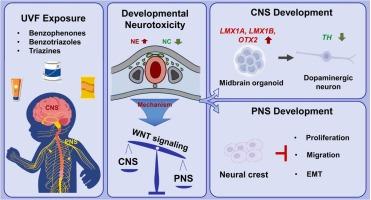Environmental UV Filters Threaten Human Neurodevelopment: Disruption of Central and Peripheral Nervous System Lineage Commitment via WNT Signaling Dysregulation
IF 11.3
1区 环境科学与生态学
Q1 ENGINEERING, ENVIRONMENTAL
引用次数: 0
Abstract
Ultraviolet filters (UVFs) are extensively employed in personal care products, coatings, and food packaging materials, raising increasing concerns regarding developmental vulnerability due to their frequent detection in breast milk and amniotic fluid. This study systematically evaluated the developmental neurotoxicity of representative benzophenone, benzotriazole, and triazine UVFs using human embryonic stem cell (hESC) differentiation models. The dynamic trajectories of both central and peripheral nervous system (CNS and PNS) development were tracked, revealing that UVFs induced an imbalanced CNS/PNS lineage commitment, with UV-328 particularly causing disruptions through direct modulation of the WNT signaling pathway. In the PNS, 10 nM UV-328 significantly inhibited proliferation and migration in neural crest cells by preventing E-cadherin downregulation. Conversely, in the CNS, BP-3, UV-328, and BEMT promoted aberrant midbrain differentiation by upregulating FOXA2, LMX1A, CORIN, OTX2, and EN1 expression, while impairing late-stage dopaminergic neuron specification by downregulating TH. These findings elucidate the molecular mechanisms underlying benzophenone, benzotriazole, and triazine UVF-induced developmental neurotoxicity and underscore the critical need to evaluate the environmental impact and safety of UVFs during sensitive developmental stages. Additionally, this study highlights the potential links between UVF exposure and neurological disorders, emphasizing the importance of continued investigation in this field to inform environmental policies and public health strategies.

环境紫外线过滤器威胁人类神经发育:通过WNT信号失调破坏中枢和周围神经系统谱系承诺
紫外线过滤器(UVFs)广泛应用于个人护理产品、涂料和食品包装材料中,由于在母乳和羊水中经常检测到紫外线,因此引起了人们对发育脆弱性的日益关注。本研究利用人胚胎干细胞(hESC)分化模型系统评估了具有代表性的二苯甲酮、苯并三唑和三嗪UVFs的发育神经毒性。研究人员追踪了中枢和外周神经系统(CNS和PNS)发育的动态轨迹,揭示了UVFs诱导CNS/PNS谱系承诺的不平衡,特别是UV-328通过直接调节WNT信号通路造成破坏。在PNS中,10 nM UV-328通过阻止E-cadherin下调显著抑制神经嵴细胞的增殖和迁移。相反,在中枢神经系统中,BP-3、UV-328和BEMT通过上调FOXA2、LMX1A、CORIN、OTX2和EN1的表达来促进中脑异常分化,同时通过下调TH来损害晚期多巴胺能神经元的规范。这些发现阐明了二苯甲酮、苯并三唑和三嗪uvf诱导发育神经毒性的分子机制,并强调了评估uvf在敏感发育阶段的环境影响和安全性的迫切需要。此外,这项研究强调了紫外线辐射暴露与神经系统疾病之间的潜在联系,强调了在这一领域继续进行调查的重要性,以便为环境政策和公共卫生战略提供信息。
本文章由计算机程序翻译,如有差异,请以英文原文为准。
求助全文
约1分钟内获得全文
求助全文
来源期刊

Journal of Hazardous Materials
工程技术-工程:环境
CiteScore
25.40
自引率
5.90%
发文量
3059
审稿时长
58 days
期刊介绍:
The Journal of Hazardous Materials serves as a global platform for promoting cutting-edge research in the field of Environmental Science and Engineering. Our publication features a wide range of articles, including full-length research papers, review articles, and perspectives, with the aim of enhancing our understanding of the dangers and risks associated with various materials concerning public health and the environment. It is important to note that the term "environmental contaminants" refers specifically to substances that pose hazardous effects through contamination, while excluding those that do not have such impacts on the environment or human health. Moreover, we emphasize the distinction between wastes and hazardous materials in order to provide further clarity on the scope of the journal. We have a keen interest in exploring specific compounds and microbial agents that have adverse effects on the environment.
 求助内容:
求助内容: 应助结果提醒方式:
应助结果提醒方式:


